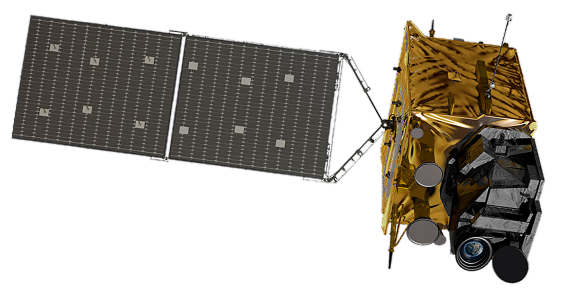



KARI developed Cheollian 1, Korea’s first geostationary satellite capable of independent meteorological and ocean observation services. It has also developed and operated Cheollian 2A, which is capable of more precise meteorological observation than Cheollian 1, and Cheollian 2B, which is capable of marine observation around the Korean Peninsula as well as the world’s first atmospheric environmental observation from the geostationary orbit.
With the development of Cheollian 1, Korea became the world’s seventh country to have an independent meteorological satellite. Cheollian 2A, the successor to Cheollian 1, is performing a more advanced meteorological observation mission. Cheollian 2B is expected to help resolve conflicts between countries and social problems due to fine dust by identifying the migration path of air pollutants, such as fine dust, around the Korean Peninsula.
The main body development technology secured during the development of Cheollian 1 and subsequent Cheollian 2A and 2B will be used as a basic platform for developing communication/broadcasting satellites or navigation satellites in the future. Moreover, the unique domestic model of the mid-sized geostationary satellite built through the development of the Cheollian 2 satellites can be applied to the development of geostationary satellites in the future. It is considered to have laid the foundation for domestic geostationary satellite development technology to reduce satellite development costs and improve technology reliability.
| Type | Cheollian 2A | Cheollian 2B | |
|---|---|---|---|
| Weather Payload | Marine Payload | Environmental Payload | |
| Resolution | Local observation, extended local observation, and global observation: - Visible light (0.6 μm band: 0.5 km) - IR: 2 km | Regional observation: 250 m Global observation: 1000 m | 7 km (south-north direction based on Seoul) |
| Channels | 16 channels (Visible : 4 channels IR: 12 channels) | 13 channels (Visible : 9 channels, Near IF: 3 channels, and wide bandwidth: 1 channel) | 1000 channels(0.2 ㎚×1000 spectral data reception)(Hyperspectroscope), UV/visible channels) |
| Observation Cycle | Local observation: 30 times/hrExtended local observation: 30 times/hrGlobal observation: 6 times/hr | Regional observation: 10 times/day (daytime)Global observation: 1 time/day (daytime) | 8 times or more/day (daytime) |
| Observation Time | Local observation: ≤ 2 minutesGlobal observation: ≤ 10 minutes | Regional observation: At HH:15 of every hour (daytime) | At HH : 45of every hour (daytime) |
| Observed area and image | Global (FD) and extended local observation (ELA):3,800 km (east-west) × 2,400 km (north-south)Local observation (LA):1,000 km×1,000 km | Regional observation (LA): 2,500 km×2,500 km Global observation (FD) | Regional observation (East Asia): 5,000 km×5,000 km |
| Development Entity | Harris (US) | Airbus (France) - KARI joint development | BATC (US) - KARI joint development |